Amazon's Arm-based Graviton2 Against AMD and Intel: Comparing Cloud Compute
by Andrei Frumusanu on March 10, 2020 8:30 AM EST- Posted in
- Servers
- CPUs
- Cloud Computing
- Amazon
- AWS
- Neoverse N1
- Graviton2
SPEC - MT Performance (4xlarge 16 vCPU)
The 64-core results were quite interesting and put the Graviton2 in a very competitive performance position, but all this talk about performance scaling varying depending on the loaded core count of the system made me wonder how the EC2 instances would perform at lower vCPU counts.
I fired up the same tests, just this time around with only rate-16 to match the number of vCPUs. These are 4xlarge EC2 instances with corresponding 16 vCPUs, but there’s one large caveat in this comparison that we must keep in mind: The Graviton2 instances very likely have no neighbours at this point in time in the test preview, meaning the performance scaling we’re seeing here is very much a best-case scenario for the Amazon chip. EC2 global capacity floats around at 60% active usage, and I imagine Amazon distributes this horizontally across the available sockets in their datacentres. How these performance figures will look like in the real world once Graviton2 ramps up in public availability is anybody’s guess.
The AMD system likely won’t care too much about such scenarios as their NUMA nature means they’re isolated from noisy neighbours anyhow, and we’re just seeing use of a single 8-core chip with its own memory controllers, but the Intel system will have possibly some neighbours doing some activity on the same socket and shared resources. I only ran one test run here; you’d probably need a lot of data to get a representative figure across EC2 usage.
For the Intel m5n instances, using an 4xlarge instance actually means you're only on on single socket this time around, meaning that the scaling behaviour in favour of higher per-thread performance isn't to be expected as high as on the Graviton2 system, as system DRAM bandwidth and L3 is halved compared to the 16xlarge figures on the previous page.
Also, since we’re testing 16 vCPU setups here, we can have an apples-to-apples comparison between the first- and second-generation Graviton systems which should be a fun comparison.
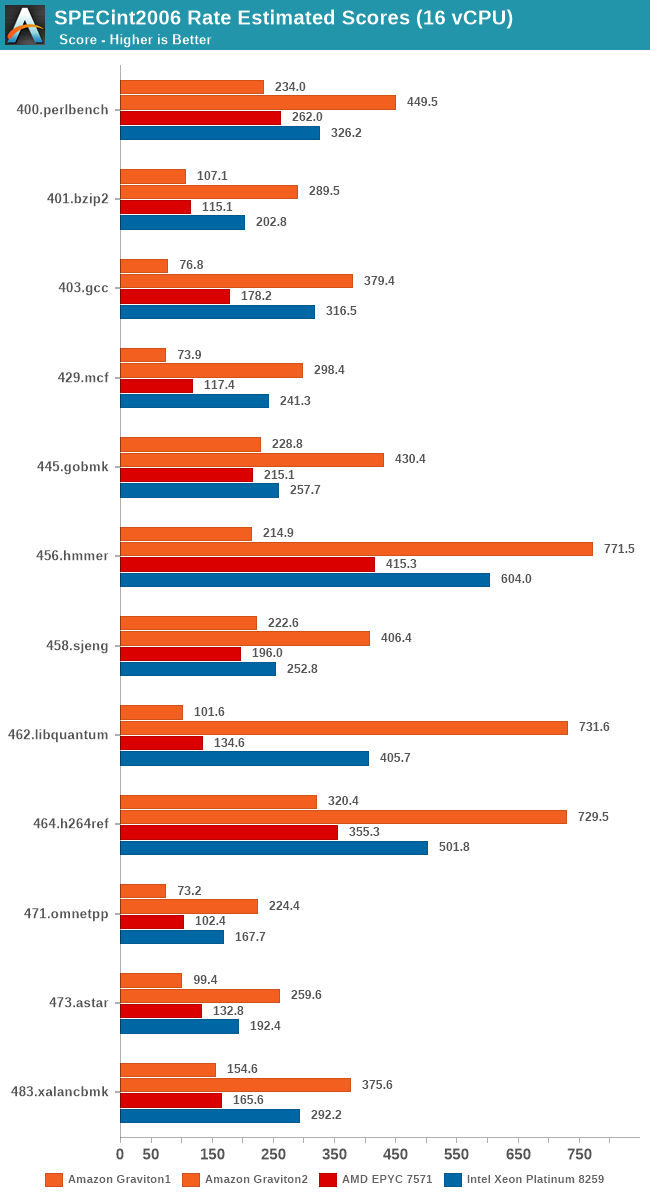
The comparison between the two generations of Graviton processors here is also astounding. Memory intensive workloads favour the newer Graviton2 by at least a factor of 2x, more often 3x, 4x, 5x and even up to 7x in libquantum.
The AMD system as expected doesn’t gain much scaling from using less cores as there’s no more shared resources available on a per-thread basis. The Intel chip fares slightly better per-thread, but doesn’t see the same higher performance scaling (Or should I say, reverse-scaling) as achieved by the Graviton2.
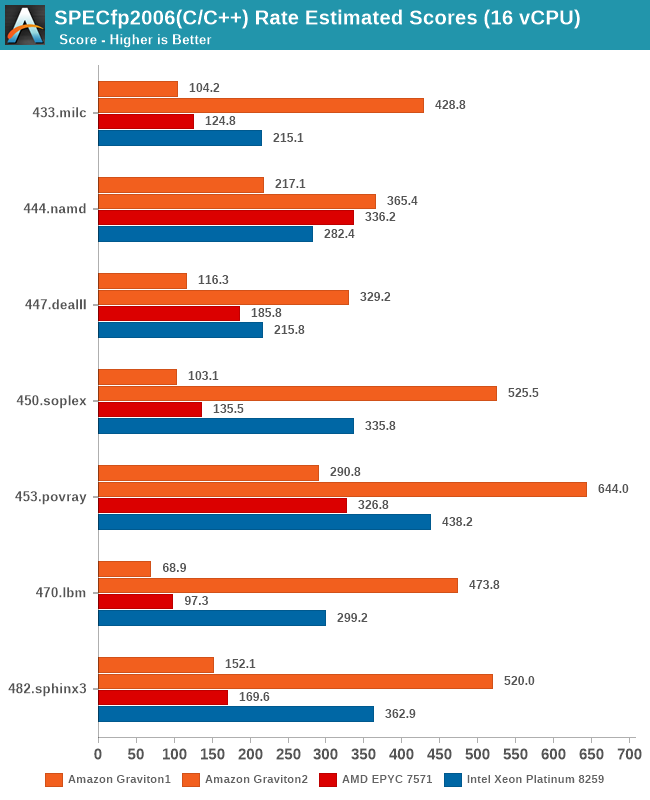
In fp2006, we see more or less the same kind of results.
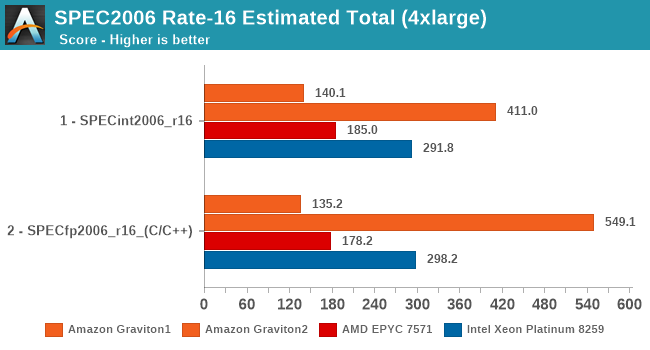
Overall, in the 16-vCPU rate results the Graviton2 surpasses the performance advantage it showcased in the 64-core results, ending up with an even bigger margin.
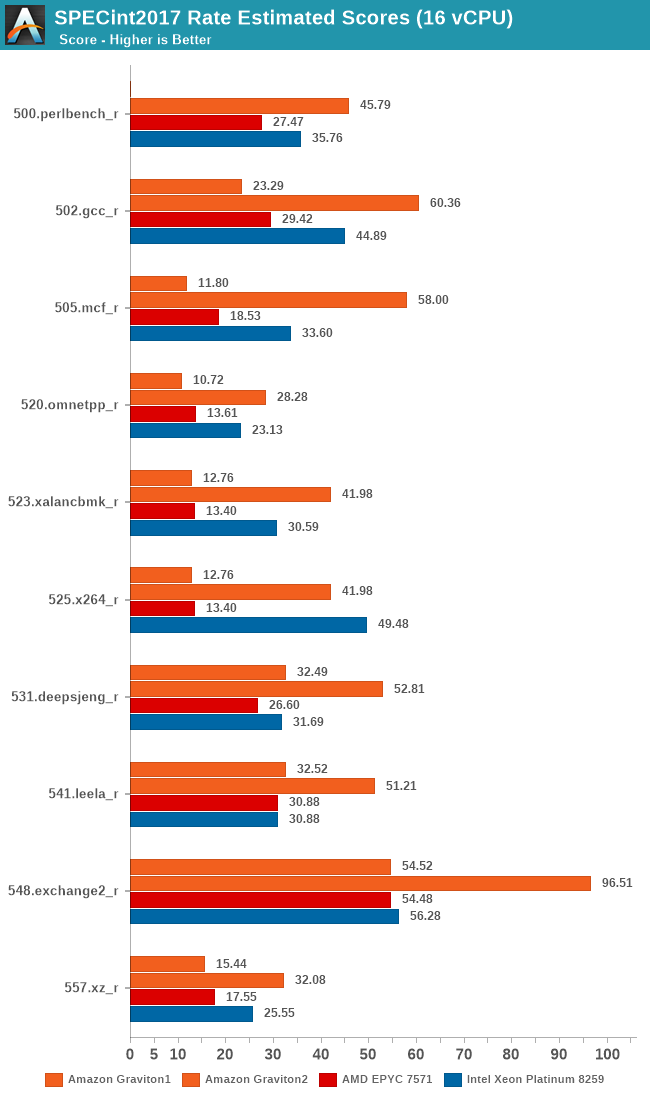

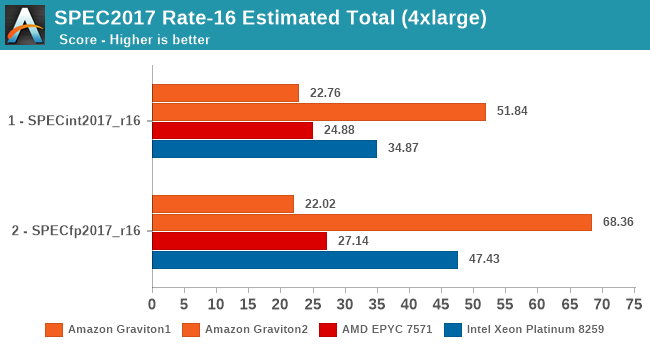
The SPEC2017 results again show the same conclusion – the Graviton2 really gains a ton of per-thread performance through the ability to use more of the chip’s L3 cache and 8 memory channels. Whilst on the 64-rate results the Graviton2 and the Xeon were neck-in-neck in fp2017, here the Graviton ends up with a 44% performance advantage.
Again, I can’t put enough emphasis on this, but these results are a best-case scenario for the 4xlarge 16vCPU results of the Graviton2. If production instances are able to achieve such figures will very largely depend on the draw of luck on whether you’re going to be alone on the physical hardware or whether you’ll have any neighbours on the chip. And even if you have neighbours, the performance figures will largely depend on what kind of workloads they will be running alongside your use-cases.
I saw a few articles out there comparing the performance between the m6g instances against the m5 generation instances (Skylake-SP hardware), but most of these tests were done only on medium (1 vCPU) to xlarge (4 vCPUs). When reading such pieces, it’s naturally important to keep in mind the vast scaling advantage the Graviton2 chip has – the smaller your instance is the more chance you’ll have noisy neighbours on the hardware, something that currently just doesn’t happen in the Graviton2’s preview phase.










96 Comments
View All Comments
notladca - Tuesday, March 10, 2020 - link
I would love to know if the product line has split within Annapurna. In other words whether Graviton2 has, like previous Annapurna SoCs, some interesting support around storage and networking for use in future Nitro. It's possible Amazon has some behind the scenes work going on with CCIX for future machines. For example integrating their Inferentia chip more closely with the SoC.Given the core count, it'd also be interesting to compare ML inference acceleration via fp16 and int8 dot product instructions per core vs use of GPU or Inferentia.
coder543 - Tuesday, March 10, 2020 - link
One small bit of feedback: with that CPU topology chart, the coloration seems a little off. A difference of +/- 1 yields very different shades of red and orange, but the same difference on the green side of the spectrum yields no discernible difference in color? Personally, I think all of the 200 +/- 5 values in the first topology chart should be an almost uniform sea of orange/red. The important thing is the 150 difference in latency, not the +/- 1 latency, and the noise in the colors distracts the reader from the primary distinction. A lower signal to noise ratio.Also: what is the unit? nanoseconds? microseconds? milliseconds? I can’t figure it out, and it’s not labeled as far as I can tell.
Andrei Frumusanu - Tuesday, March 10, 2020 - link
Nanoseconds, I'll add a remark.sing_electric - Tuesday, March 10, 2020 - link
My tin hat is telling me to be suspicious of Amazon's pricing here. When shopping for cloud computing, perf/$ becomes VERY alluring, but I have to wonder if Amazon is willing to let its Gravitron servers be a "loss leader," artificially lowering prices to get market share until Arm on server is well-established - before then raising prices to something closer to a economically sustainable number.Andrei Frumusanu - Tuesday, March 10, 2020 - link
Vertical integration is powerful. Amazon can share profits and margins division wide, not having to pay overhead to AMD/Intel.sing_electric - Tuesday, March 10, 2020 - link
True, but then Amazon has to pay for the ARM license and 100% of the development/production costs. I would be very surprised if they managed to *make money* on the 1st couple Graviton generations (especially if you factor in having to buy Annapurna), since you'd need to say "of the $X generated by Graviton metal, $Y would have been spent on EC2 anyways, meaning $Z is our actual gain," and that's... probably too much to ask at this stage.rahvin - Tuesday, March 10, 2020 - link
The costs you mention are nothing compared to what they pay right now with Intel or AMD with they 50% margins on top of the actual cost. IMO this initiative was born out of Intel's price increases from 2010 to now. By vertically integrating they have full control over the price structure and they have very good data on what kind of workloads are running so they can tailor the design.IMO it was just a question of time until Amazon tried to vertically integrate this like they've done with shipping and lots of other stuff. Bezos is following the Robber Barron growth model.
dotjaz - Wednesday, March 11, 2020 - link
Huh? AMD has a gross margin of 40%, true. But keep in mind AWS has a operating margin of 30%, that mean AWS has a even higher gross margin than AMD, comparable to AMD's server department.Do you know what that means? For $1 of expenditure in to chip manufacturing, AWS expects to earn as much as AMD does. And since AWS don't have the volume as far as chip goes, their gross margin for chip investment will be lower, therefore not worth the investment if the decision is purely financial.
But yes, the other point stands, AWS have better control of costing (with more leverage as well) and performance.
Wilco1 - Wednesday, March 11, 2020 - link
For every $1 worth of silicon you could pay AMD $1.50, pay Intel $2 or pay TSMC $1 plus $0.20 internal development costs. Which works out best you think?extide - Friday, March 13, 2020 - link
It's not that simple. AMD and Intel can spread those development costs over vastly more processors. I mean we'll never know how it truly breaks down -- but I'd imagine Amazon has figure this all out and this will be pretty profitable for them.